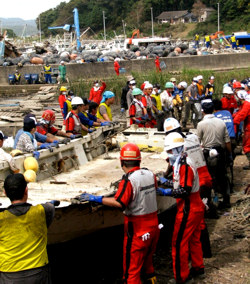Japan, one year on
April is a time for new beginnings in Japan. As the cherry blossoms hit full bloom, hanami (flower viewing) parties and picnics take place all over the country, the school year starts and companies hire new recruits. The blossoms, which only bloom for a short period, are a symbol of transience in Japanese culture. Japanese literature and art is full of references to these little pink petals as testaments to the fragility of beauty, and of life.
Last year, in many parts of Japan, hanami didn’t happen. Public parks and river banks, usually teeming with revellers, were eerily quiet. The cherry blossom season arrived less than a month after the triple disasters of March 11, which killed nearly 20,000 people and left close to a million homeless in Tohoku, the northeastern part of Japan.
I was in Kyoto when the earthquake and tsunami hit. I scrambled to contact friends in northeastern Japan, as mobile phone networks were out or limited to emergency use. Days or weeks later, a message would come describing a horrible ordeal.
 Eisho Naito and his two children
Eisho Naito and his two childrenEisho Naito
When I went to Tokyo last spring, a time when it would normally be almost impossible to get a Shinkansen seat, or find a hotel room, I felt like I had arrived in a ghost town. At Tokyo Station, one of the busiest railway stations in the world, my footsteps echoed along the concourse. In Ueno Park, usually hanami party central, there were just a few sombre gatherings. To show solidarity with the people of Tohoku, Tokyoites – indeed people all over Japan – refrained from celebrations.
Over the past year, there has been a huge amount of aid to the Tohoku region from humanitarian groups, as well as fundraising activities worldwide. Volunteer efforts to clear the debris, rebuild homes and businesses, and provide psychosocial support have helped the victims of the disaster to begin the task of rebuilding their lives and communities. Back in Kyoto, which was not affected by the disasters, I helped raise funds with “Inspire Japan”, a global show-and-tell event whose proceeds go to reconstruction projects in affected areas of Japan.
 Volunteers are needed to clear debris
Volunteers are needed to clear debrisPeace Boat
One year on, tourism-related businesses are finally getting back to normal – once again foreign languages can be heard along Kyoto’s quaint and narrow streets and tranquil temple gardens are buzzing with tour groups. Keiji Shimizu runs three popular backpacker hostels near Kyoto Station and is a mine of information on the cheapest places to eat Kyoto’s famous kaiseki cuisine or find a hidden onsen (hot spring). Like many people I’ve talked to over the past 12 months, the disasters have reinforced his sense of pride in Japanese culture and history, and a desire to show more of it to the world. “Only in Kyoto can you come across 17 UNESCO World Heritage sites all in one city,” he says, “tourists shouldn’t hesitate to come and experience its historical and modern traditions.”
 One of many UNESCO sites in Kyoto
One of many UNESCO sites in KyotoWTG / Coralie Modschiedler
THE FACTS
Is it safe to visit Japan?
Apart from the exclusion zone surrounding the Fukushima nuclear power plant, Kylie Clark of the Japan National Tourism Organization, says that Japan has been declared safe for tourists by a number of international organisations and foreign governments. Hideyuki Ban, of the Citizens’ Nuclear Information Center in Tokyo, says that anyone concerned about exposure to radiation should avoid Fukushima Prefecture. He also encourages visitors to check radiation levels themselves before visiting (http://radioactivity.mext.go.jp/en).
What about food safety?
Both agriculture and fishing have been affected by the disaster, and although the Japanese government insists it is conducting rigorous checks on food and water, there is much debate over safe levels. “Japanese consumers are very concerned about food safety and are monitoring it closely themselves,” says Kyoto hostel owner Keiji Shimizu. Stephen Gill, who lives in Japan and recently travelled to Tohoku for a BBC Radio 4 documentary, believes that eating produce in Fukushima is very risky, but visitors on short trips needn’t be concerned about food safety in parts of Japan not affected by the disasters.
How can visitors help?
 April is the best time to visit Japan
April is the best time to visit JapaniStockphoto / Thinkstock
What preparations are needed for volunteering?
Participation in a one-day orientation session and the purchase of special volunteer insurance may be required by some organisations – check websites for details. It is recommended that volunteers bring their own work clothes, rubber boots, work gloves, rain gear and other essentials.
How is the atmosphere in key destinations?
 Tokyo is back to normal
Tokyo is back to normaliStockphoto / Thinkstock
Is it cheaper to visit Japan now?
Many airlines are offering special fares to Japan during the upcoming cherry blossom season (see details below). The Visit Japan campaign has a Super Saver Coupon, offering perks such as discounts, free drinks and gifts at hundreds of restaurants, shops, sightseeing places and hotels all over Japan.
What should visitors look forward to this year?
Kyoto’s Miyako Odori geisha dances are performed throughout April and are a great opportunity to see elegant traditional dances and beautiful silk kimono costumes. The line-up for this year’s Fuji Rock Festival in late July includes Radiohead, The Stone Roses and Elvis Costello. Aomori’s Nebuta festival, held in August, has a stunning night parade of illuminated floats. The Echigo-Tsumari Art Triennale, from July to September, will host 580 local and international artists.
NEED TO KNOW
Getting there:
• Virgin Atlantic is offering a special Tokyo fare from £635 (for booking made by 31 March)
• Cathay Pacific has special fares to Tokyo, Osaka, Nagoya, Fukuoka and Sapporo from £549 (for bookings made by 31 March)
• KLM is offering a special Osaka fare from £550 (for bookings made by 12 April)
• Air France has special fares to Tokyo and Osaka from £549 (for bookings made by 12 April)
Recommended volunteering organisations:
• Peace Boat Emergency Relief Operation
• INJM – It’s Not Just Mud
• JEN – Japan Emergency NGOs
• Foreign Volunteers Japan
Do you have any Feedback about this page?
© 2025 Columbus Travel Media Ltd. All rights reserved. No part of this site may be reproduced without our written permission, click here for information on Columbus Content Solutions.









 You know where
You know where